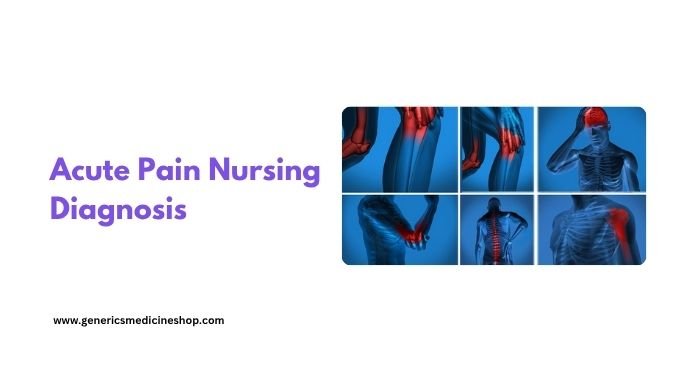Acute pain is a common yet complex clinical issue in nursing practice. It requires timely assessment, accurate diagnosis, and effective intervention to improve patient outcomes. Among various pain management strategies, Tapentadol has emerged as a powerful tool in treating acute pain. This article discusses the nursing diagnosis for acute pain, including assessment techniques, care planning, interventions, and the role of Tapentadol in effective pain control.
What Is Acute Pain?
Acute pain is defined as sudden-onset pain that typically lasts less than 6 months and is usually linked to injury, surgery, or illness. Unlike chronic pain, acute pain has a clear cause and resolves as healing occurs.
NANDA Nursing Diagnosis for Acute Pain
The official NANDA-I (North American Nursing Diagnosis Association-International) definition for acute pain is:
“An unpleasant sensory and emotional experience arising from actual or potential tissue damage or described in terms of such damage; sudden or slow onset of any intensity from mild to severe with an anticipated or predictable end and a duration of less than 6 months.”
Nursing Diagnosis Label:
Acute Pain related to [cause] as evidenced by [signs/symptoms].
Common Causes of Acute Pain
- Surgical procedures (e.g., post-operative pain)
- Injuries (e.g., fractures, burns, cuts)
- Labor and childbirth
- Infections (e.g., sore throat, urinary tract infection)
- Acute illnesses (e.g., appendicitis, pancreatitis)
Signs and Symptoms of Acute Pain
Patients may present with the following indicators:
- Verbal expressions of pain (“It hurts,” “Sharp pain”)
- Grimacing, moaning, or crying
- Increased heart rate (tachycardia)
- High blood pressure
- Sweating (diaphoresis)
- Restlessness or guarding behavior
- Decreased physical activity
Nursing Assessment for Acute Pain
A thorough pain assessment is essential for an accurate nursing diagnosis. Use the PQRST method:
| P | Provoking Factors – What triggers or worsens the pain? |
| Q | Quality – What does the pain feel like (sharp, dull, throbbing)? |
| R | Region/Radiation – Where is the pain? Does it radiate? |
| S | Severity – Use a pain scale (0–10) |
| T | Timing – When did the pain start? How long does it last? |
Also consider:
- Patient’s pain history
- Cultural or psychological factors
- Non-verbal cues in non-communicative patients
Nursing Care Plan for Acute Pain
Here is an example of a comprehensive nursing care plan using the NANDA format.
Nursing Diagnosis:
Acute pain related to surgical incision as evidenced by verbal reports of pain rated 8/10, facial grimacing, and guarding behavior.
Goal/Outcome:
- Patient will report a decrease in pain to 3/10 or lower within 24 hours.
- Patient will demonstrate relaxation techniques by the end of the shift.
- Patient will verbalize understanding of pain management plan.
Nursing Interventions for Acute Pain
- Assess Pain Regularly
- Use pain scales (Numeric, Wong-Baker Faces, FLACC for children).
- Monitor vital signs associated with pain (BP, HR, RR).
- Administer Pain Medication as Prescribed
- Use analgesics, such as:
- NSAIDs (e.g., ibuprofen, ketorolac)
- Acetaminophen
- Opioids (e.g., tapentadol, Aspadol) when appropriate
- Follow the “5 Rights” of medication administration.
- Provide Non-Pharmacologic Interventions
- Positioning for comfort
- Cold or heat therapy (based on patient condition)
- Deep breathing exercises
- Distraction techniques (TV, music, reading)
- Guided imagery or relaxation techniques
- Educate the Patient
- Explain the purpose and expected effects of pain medications
- Teach about the importance of reporting pain early
- Encourage use of pain scales to improve communication
- Collaborate with the Healthcare Team
- Notify physicians if pain is not controlled
- Involve physiotherapists for movement-related pain
- Consult pain management specialists if needed
Evaluation
The effectiveness of the nursing care plan is evaluated by:
- Reduction in pain score
- Improved physical function (e.g., mobility)
- Increased participation in daily activities
- Absence of adverse reactions from medications
Example:
Patient reported pain reduced from 8/10 to 2/10 within 4 hours of medication and relaxation techniques.
Documentation Tips for Nurses
Accurate documentation of pain and interventions is critical:
- Record pain score, location, and description
- Note medication given (dose, time, route)
- Report patient’s response to interventions
- Update care plan based on effectiveness
Importance of Addressing Acute Pain in Nursing
Uncontrolled acute pain can:
- Delay healing
- Decrease patient satisfaction
- Increase the risk of complications like pneumonia (from immobility)
- Lead to chronic pain conditions
Timely and appropriate pain management is part of holistic nursing care, improves outcomes, and enhances the patient’s overall hospital experience.
Conclusion
A well-structured nursing diagnosis and care plan for acute pain empowers nurses to effectively manage a patient’s discomfort, promote healing, and improve quality of care. Combining clinical skills, accurate assessments, appropriate interventions, and patient education ensures successful pain control and faster recovery.







